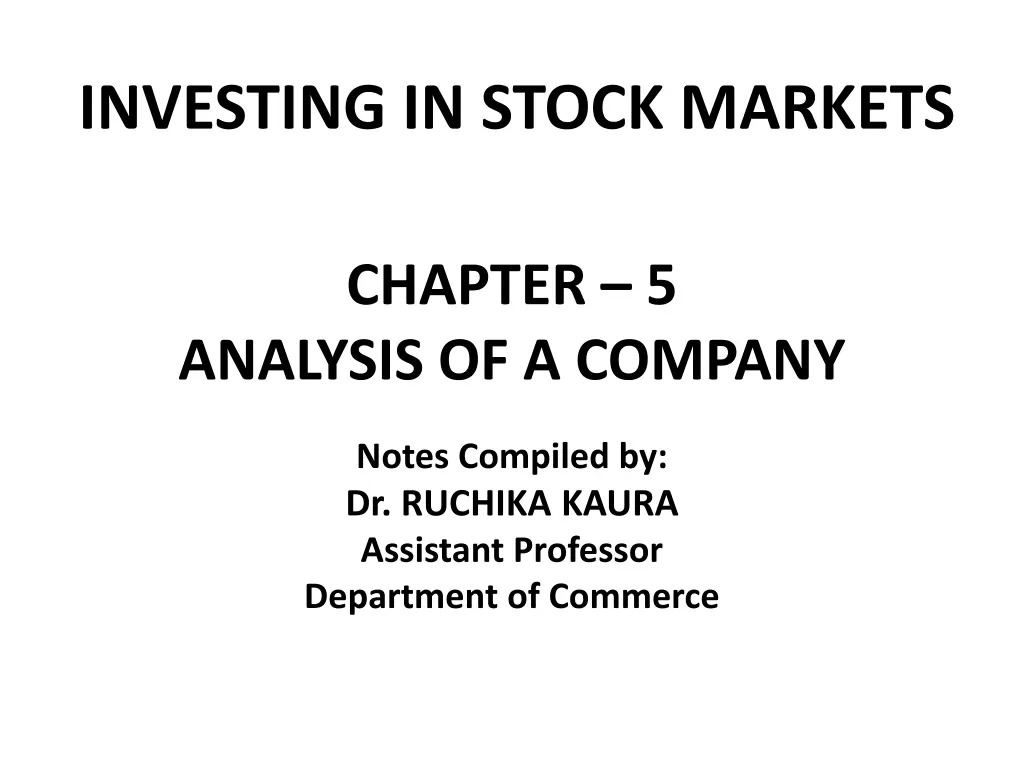
Mastering Company Analysis for Stock Market Investing
Discover the essential factors and methods involved in analyzing a company for investment purposes. Learn about the EIC approach, financial and non-financial factors, ratio analysis, and more to make informed investment decisions in the stock market.
Download Presentation

Please find below an Image/Link to download the presentation.
The content on the website is provided AS IS for your information and personal use only. It may not be sold, licensed, or shared on other websites without obtaining consent from the author. If you encounter any issues during the download, it is possible that the publisher has removed the file from their server.
You are allowed to download the files provided on this website for personal or commercial use, subject to the condition that they are used lawfully. All files are the property of their respective owners.
The content on the website is provided AS IS for your information and personal use only. It may not be sold, licensed, or shared on other websites without obtaining consent from the author.
E N D
Presentation Transcript
INVESTING IN STOCK MARKETS CHAPTER 5 ANALYSIS OF A COMPANY Notes Compiled by: Dr. RUCHIKA KAURA Assistant Professor Department of Commerce
Important Questions from this Chapter 1. What do you mean by analysis of a company? What are the main factors considered while analysis? 2. What are the key financial factors in analysis of a company? Do you think that the performance evaluation of a company just on the basis of financial factors is sufficient? conducting company
EIC Approach E Economy; I Industry: C Company EIC approach is a broad three-tier approach of considering the overall economy, the industry and then the company for analysis. A company can not exist in isolation. It is a part of the industry and the industry is a part of the economy. If an investor considers only the company analysis, this is a narrow and limited approach because a company s performance may be affected by the performance of the industry within which a company operates and similarly, the performance of an industry may depend upon the overall environment of the economy in which the industry exists.
Analysis of a Company - Meaning Company analysis is a part of broad three-tier EIC approach. Company analysis means competitive position, profitability and future prospects of a company. It consists of finding out the intrinsic value of a company s security as against its market value. An investors needs to do company analysis so that he/she can decide that which company is most suitable for his/her investment. assessing earning the capacity,
Factors to consider in Company Analysis Financial Factors Non-Financial Factors Ratio Analysis Balance-Sheet Analysis Cash Flow Analysis Capital Structure Analysis Comparative Financial Statements Common Size Financial Statements Fund Flow Analysis Trend Percentages Nature of Business Company s Market Share Efficiency of Management Raw Material Availability Government Policy Competitive Strength of the Company Technology Used Product Range/ Diversification Research and Development Growth Cycle of the Company
Ratio Analysis Liquidity Ratios Solvency Ratios Activity Ratios Profitability Ratios Current Ratio Quick Ratio Debt to Equity Ratio Total Assets to Debt Ratio Proprietary Ratio Stock Turnover Ratio Debtors Turnover Ratio Working Capital Turnover Ratio Gross Profit Ratio Net Profit Ratio Operating Ratio Return on Investment Earning Per Share
Ratio Analysis Ratios Meaning Formula Current Ratio Shows relation between current assets and current liabilities. Current Assets / Current Liabilities Quick Ratio Shows relation between quick assets and current liabilities. Quick assets include all current assets except stock and prepaid expenses. Quick Assets / Current Liabilities Debt Equity Ratio Shows relation between external equity (long term borrowed funds) and internal equity (owned funds/ shareholders funds). Debt / Equity Total Assets to Debt Ratio Shows relation between total assets (fixed as well as current) and debt (long term borrowed funds). Total Assets / Debt Proprietary Ratio Shows relation between proprietor s funds (owned funds/shareholder s funds) and total assets (fixed as well as current) of the business. Proprietor s Funds / Total Assets
Ratio Analysis Ratios Meaning Formula Stock Turnover Ratio Shows whether the amount invested in stock has been used efficiently or not. Establishes relation between cost of goods sold and average inventory. Cost of Goods Sold / Average Stock Debtors Turnover Ratio Shows the number of times the receivables are converted into cash i.e. the efficiency of the company in relation to collection of amount due from debtors. Net Credit Sales / Average Receivables Working Capital Turnover Ratio Shows the efficiency of a company in working capital utilization. Establishes relation between working capital and sales of a company. Net Sales / Working Capital Gross Profit Ratio Shows relation between company s gross profit and net sales. Tells whether the gross profit is sufficient to cover for administrative and selling expenses, fixed charges etc. (Gross Profit / Net Sales) * 100 Net Profit Ratio Shows relation between company s net profit and net sales. Tells about the overall efficiency of the business. (Net Profit / Net Sales) * 100
Ratio Analysis Ratios Meaning Formula Operating Ratio Shows the proportion of operating cost to net sales. Is a measure of company s operational efficiency. (Operating Cost / Net Sales) * 100 Return on Investment (ROI) Shows whether a company is generating enough returns on its capital employed or not. Establishes relation between net profit (Earnings after tax) and capital employed (Debt plus equity). (Net Profit / Capital Employed) *100 Earning Per Share (EPS) Shows the amount of profit available per share after making all other payments. Net Profit after tax / Number of shares outstanding
Cash Flow Statement The cash flow statement is a financial statement that summarizes the amount equivalents of a company for a period. The cash flow statement (CFS) measures how well a company manages its cash position, meaning how well the company generates cash to pay its debt obligations and fund its operating expenses. A cash flow statement company's cash sources and uses for the period into three categories: cash flow from operating activities cash flow from investing activities and cash flow from financing activities. of cash and cash typically breaks out a
Balance-Sheet Analysis Balance Sheet tells investors how much money a company has (assets), how much it owes (liabilities), and what is left when you net the two together (net worth or shareholder equity). By analyzing a company's financial information, an investor can determine: How much debt the business has relative to its equity Whether short-term cash is declining or increasing The percentage of assets that are tangible (e.g., factories, plants, and machinery) How many days it takes, on average, to sell the inventory the business keeps on hand Whether the research and development budget is producing good results The average interest rate a company is paying on its debt Where profits are being spent or reinvested To make sound investment decisions, it is important to read and analyse a balance sheet.
Non-Financial Factors in Analysis of a Company Nature of Business: Whether the business is dealing in capital goods or consumable goods; what is the scope of the industry in future Company s Market Share: Whether the company s share in comparison to other companies of the industry is less, reasonable or quite high. Managerial Efficiency: The vision and operational efficiency of management should be examined. Raw Material Availability: Whether the raw material it uses is easily available or not; available domestically or imported. Government Policy: Whether the government s policies are in favour of company s future prospects or not.
Non-Financial Factors in Analysis of a Company Competitive Strength Company s competitive power in terms of both financial and non-financial parameters should be analyzed. Technology Used: Whether company uses labour intensive or machine intensive technology; latest or out dated techniques Growth Cycle of Company: Whether the company has scope for further expansion or not. Research & Development: whether the company is spending amount on R & D for new products, up-gradation of techniques or not. of the Company:






















